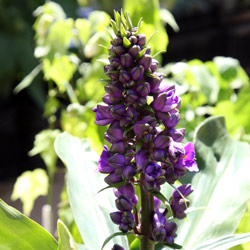
Brazilian Ginger or ‘Blue Ginger’ is a Dichorisandra thyrsiflora is a tropical to sub tropical plant grown mainly for is blue flowers. Attractive glossy dark green foliage and a good upright habit, the flowers form as terminal clusters in fall.
Over time it will form a dense clump with its cane like stems and rhizomatous root system proving very sturdy. The foliage itself has a deep blue tinge on the underside to compliment the deep blue topple flower heads.
A native to South America (Peru and Brazil) it is a plant that prefers part shade and a humus rich moist but soil. Growing to around 6ft (2m) this is a frost tender plant and may need to over wintered inside in colder areas.
Care
Generally seen as being suited to USDA Zones 10 – 11, however given protection and the right aspect they can be grown in cooler climates.
They can be grown as a potted plant and therefore over wintered in a protected position. The plant will not tolerate frosts. It can be pruned back after flowering if needed, simply cut back the older stems that have become a little to tatty.
Fertilize during the growing season with a slow release fertilizer as recommended, as well a liquid seaweed type every two weeks.
Propagation
Despite what you may read Dichorisandra thyrsiflora is not that easy to propagate by division of tubers, as these do not sprout. However division of clumps and stem cuttings are both satisfactory.
Division
- Look for an established clump and try to carefully separate some of the healthy growing sections.
- Take care to have a good part of the root system attached to each division.
- Best to keep divisions large with 4 – 5 stems in a division.
- Prune back the stems by 50 % to reduce stress, but make sure you still have some foliage on them
Stem Cuttings
An easier method is to propagate from stem cuttings. Simply find a long healthy stem.
- You will notice nodes on the stem.
- Cut the stem into sections with 4 – 5 nodes on each section.
- Simply plant them in a free draining potting soil.
- Try to keep these cuttings humid until signs of new growth are evident.

